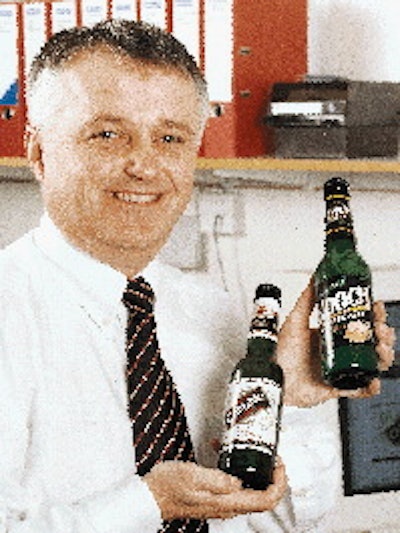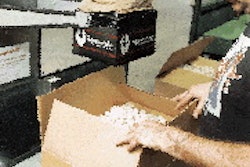On December 4, Bass Brewers of Burton-on-Trent, England, launched a 330-cL plastic bottle for both Hooper's Hooch and Carling Black Label (see Packaging World, Jan. '98, p. 2). Co-injection stretch/blow-molded by Pechiney subsidiary American National Can (Chicago, IL), the bottles consist of a barrier layer of ethylene vinyl alcohol between inner and outer layers of polyethylene terephthalate. Bottles weigh 29 g and are targeted for outdoor and stadium events, possibly nightclubs, too, where a light, shatterproof package is highly valued. Shelf life is 12 weeks. Heading up the team that developed the bottle was Bass's director of package development Bill Dando. While plenty of brewers remain skeptical about beer in plastic containers, Dando is downright enthusiastic about the compatibility of beer and plastic. Packaging World's Dec. 12 conversation with Dando follows. Why did Bass seek a plastic bottle for beer? Initially people in the brewing industry didn't want this package at all. I can still remember comments like, 'Why would anybody want to drink beer out of a plastic bottle, Dando?' But just imagine somebody inside Coca-Cola saying that [about soft drinks] 18 years ago. If they did, they're eating their words right now. Coca-Cola took an icon, a premium product, and destroyed this myth about how it has to be in glass because it's a premium product. We wanted the plastic bottle for lots of reasons. Glass breaks, and you read all the time about major companies having to do product recalls because of glass [contamination] in bottles. So there's a whole host of functional attributes that this new material offers the consumer, the filler, and the retailer that glass currently doesn't. Are your consumers ready for beer in plastic? Our research showed they're a lot more receptive to the idea than ten or even five years ago. They understand the benefits. So we saw an ideal opportunity to launch a plastic package in an area of our business-special events, outdoor occasions, nightclubs-where plastic was seen as preferable to glass from a safety and legislative point of view. We just had to address some technical hurdles to make sure the barrier properties would allow us to get the product to the consumer in the right condition. Did Bass drive this development, or did Pechiney? Obviously it takes two to tango, but by no stretch of the imagination did Pechiney knock on my door and say, 'I have a beer bottle to sell you if you want to buy it.' We scoured the world for the right barrier technology and spoke to all the major PET converters. I have to say, there was a lot of huffing and puffing from the converters' side. Some of them didn't do themselves justice, either, because they wouldn't tell us enough about what they were doing. Our feeling was, 'If you won't show us what cars you have in the show room, then we can't buy a car from you.' How would you describe your relationship with Pechiney? We saw within their technology the potential for a successful container, and we were able to work with them to push the frontiers of their technology even further in terms of what they thought their limitations were. And really that only happened because of us supplying real customer focus and a purchase order at the end of it. It became two parties whose chemistry was right and whose commitment to getting to the marketplace was right. We couldn't find that anyplace else. And not only was it a willingness to share information and technology but an equal willingness to share some of the commercial risk as well. Where is the beer filled? I wouldn't like to say, other than that we fill it at a contract filler on a line that accepts either glass or plastic bottles. At this point we're not considering filling in-house. We need to get higher volumes to justify bringing it in-house with a high-speed filling line. About a year ago in Australia, Carlton United Breweries launched a monolayer PET bottle that also was aimed at outdoor and stadium-type events, and they selected a plastic threaded closure with breakaway TE band. Why did you opt for a crown? We didn't want a short shelf life, and a crown is a much superior barrier to oxygen. We also received feedback from consumers that convinced us to make this look as much like a beer bottle as possible. That meant no petaloid base and no screw-on caps. Doesn't the plastic beer bottle look smaller than its glass counterpart? In the UK the 275-mL is a standard glass bottle for beer. We could have launched plastic in that size, but it would have looked far too small. So we launched in a 330-mL size. It looks virtually the same as the 275-mL glass. What about the oxygen absorber in the crown? It's purely belt and braces. I beg your pardon? We put it there to err on the safe side. We're not convinced it's doing a tremendous amount for us, but it's doing no harm, either. We think residual air trapped in the headspace is a minimal concern compared to oxygen coming through the sidewalls. We're just trying to make sure we take every reasonable precaution and use every available technology to enhance product quality. What are some of the complexities of affixing a crown to a plastic finish? I wouldn't like to say, other than that the crown proved to be a much more challenging technology to address than we'd originally thought. But once you've cracked it, you don't have to worry about oxygen ingress through the threads. The figures coming back from the TNO research in Europe are showing that up to thirty percent of the oxygen that enters a bottle comes through the threads. [Editor's note: The TNO Nutrition and Food Research Institute of Zeist, the Netherlands, has launched a multi-client study titled "Synthetic Containers for Beer."] We were involved in the TNO study, but we withdrew. Professionally it was getting to be a conflict because the TNO study encouraged companies to share information, while we were trying to develop something exclusive to Bass. Besides, we didn't want to wait for the results of the TNO study. We wanted to have a package in the marketplace before those results came out. Are any special measures taken in distributing the plastic bottle? No, it's strictly standard distribution. Typically we shrink wrap twenty-four bottles in a corrugated tray and palletize them. If the bottles are going to a special event, it's likely they'll go directly to the customer. For pubs, clubs or hotels, they'll probably go through central warehouses and then to a cash-and-carry outlet. We've launched with a twelve-week shelf life because that's what real-time data tells us is okay. But we do have product in stability testing, and we'd expect to continue extending that shelf life as we obtain real-time data. Can a 330-cL plastic bottle come close to matching the shelf life provided by a 330-cL glass bottle? Our glass bottle and process provides nine months, and we won't reach that with this bottle. But other developments are underway, both in terms of materials and processing, which I would hope put us within striking distance of nine months. I think six to nine months is realistic. Did you consider polyethylene naphthalate as a barrier material? Yes, but it might have cost five times as much. What PEN did do for us, however, is create some light at the end of the tunnel. It convinced us that there was a material that could be made to work. How costly is this PET/EVOH/PET bottle? I can only say it costs significantly more than a glass bottle. But we're working on that. Why are preforms made in Ohio and blowing done in Illinois? Long term we'll look to source the bottle in the UK or Europe. Can the Pechiney technology produce bottles at acceptable rates? Not initially, but we now have bottle-making speeds up to what Pechiney considers acceptable. What about environmental concerns over yet another plastic bottle? Based on conversations with converters and recycling people, because there is no tie layer in the structure, the bottle will be given a #1 code for its recycling symbol. As there isn't much PET recycling done in the UK at this point, it isn't a big issue at the moment. But if we increase volume, then we'd want to address those issues in advance. Those are the bridges we want to cross when we get a bit more feel for the scope of this opportunity. Are these beverages cold-filtered or pasteurized? With the exception of this bottle, all our beers are pasteurized. One of the things we consider valuable know-how and that I'd like to keep confidential is the way we get the beer into the bottle, with a minimum of oxygen, in the first place. What I can say is that it's not a heat-set bottle. What about the future? It's only been out a week, and we need to wait for some feedback to judge properly. But the response has been incredible. Consumers are almost adopting the attitude now of 'What's the big deal?' Which I find fantastic in such a short time. It's got us thinking about taking the next step in terms of scaling up. Bottles for special events was only phase one. Phase two is a more general release through the "leisure channel," which is clubs, pubs, restaurants and hotels. And phase three is penetration into retail sectors as a replacement for glass. Will the current bottle get us there? It's touch-and-go. We'll need at least six months shelf life, so some barrier enhancement may be required. It may be through Pechiney's technology, but we're actively looking at others. Technologies have been emerging quickly, but until now they were only being driven as fast as the market need. And if people aren't selling beer in plastic bottles, why should bottle converters push their technologies? The difference now is that we can go to bottle converters with real sales forecast volumes. We can say, 'We want the least-cost bottle with the best shelf life. Who's got it?' Next month in Packaging World: What about plastic for Anheuser-Busch?



























